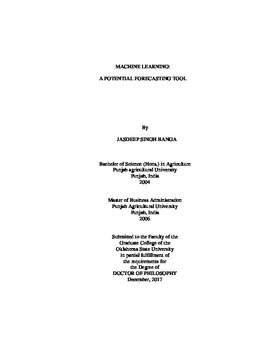| dc.contributor.advisor | Brorsen, B. Wade | |
| dc.contributor.author | Banga, Jasdeep Singh | |
| dc.date.accessioned | 2018-06-25T13:38:22Z | |
| dc.date.available | 2018-06-25T13:38:22Z | |
| dc.date.issued | 2017-12 | |
| dc.identifier.uri | https://hdl.handle.net/11244/300244 | |
| dc.description.abstract | Technical analysis involves predicting asset price movements from analysis of historical prices. Many studies have been conducted to determine the profitability of technical analysis. A composite prediction is considered here by using the buy and sell signals from technical indicators as inputs. Both machine learning methods like neural networks and statistical methods like logistic regression are used to get composite forecasts. Signals from trend-following and mean-reversal technical indicators are used in addition to variance of prices as inputs. Variance is added to help technical indicators switch between trend-following and mean-reversal systems. Five commodities from agricultural, livestock and foreign exchange futures markets are selected to test the hypothesis of profitability of technical indicators. Special care is taken to avoid data snooping error. | |
| dc.description.abstract | None of the individual indicators or machine learning models generate significant profit in single day forecasts. In twenty-day forecasts, only random forest and pipeline models are profitable. Neural networks and statistical models both failed to deliver here. The out of sample failure of the neural networks is partly due to the relatively large number of parameters. Managed futures, however also did poorly in the out of sample period so the results could also be due to picking a time period where technical analysis did poorly. Individual indicators did occasionally show significant profits. Random forests and decision tree find variance as the most important input. Future research should consider alternative time periods, commodities, systems, and machine learning algorithms. If a scale neutral variable for variance could be developed, it should be used so that the models could be trained on data from multiple commodities to provide more training data. | |
| dc.format | application/pdf | |
| dc.language | en_US | |
| dc.rights | Copyright is held by the author who has granted the Oklahoma State University Library the non-exclusive right to share this material in its institutional repository. Contact Digital Library Services at lib-dls@okstate.edu or 405-744-9161 for the permission policy on the use, reproduction or distribution of this material. | |
| dc.title | Machine learning: A potential forecasting tool | |
| dc.contributor.committeeMember | Anderson, Kim | |
| dc.contributor.committeeMember | Devuyst, Eric A. | |
| dc.contributor.committeeMember | Krehbiel, Tim | |
| osu.filename | Banga_okstate_0664D_15556.pdf | |
| osu.accesstype | Open Access | |
| dc.type.genre | Dissertation | |
| dc.type.material | Text | |
| thesis.degree.discipline | Agricultural Economics | |
| thesis.degree.grantor | Oklahoma State University | |
